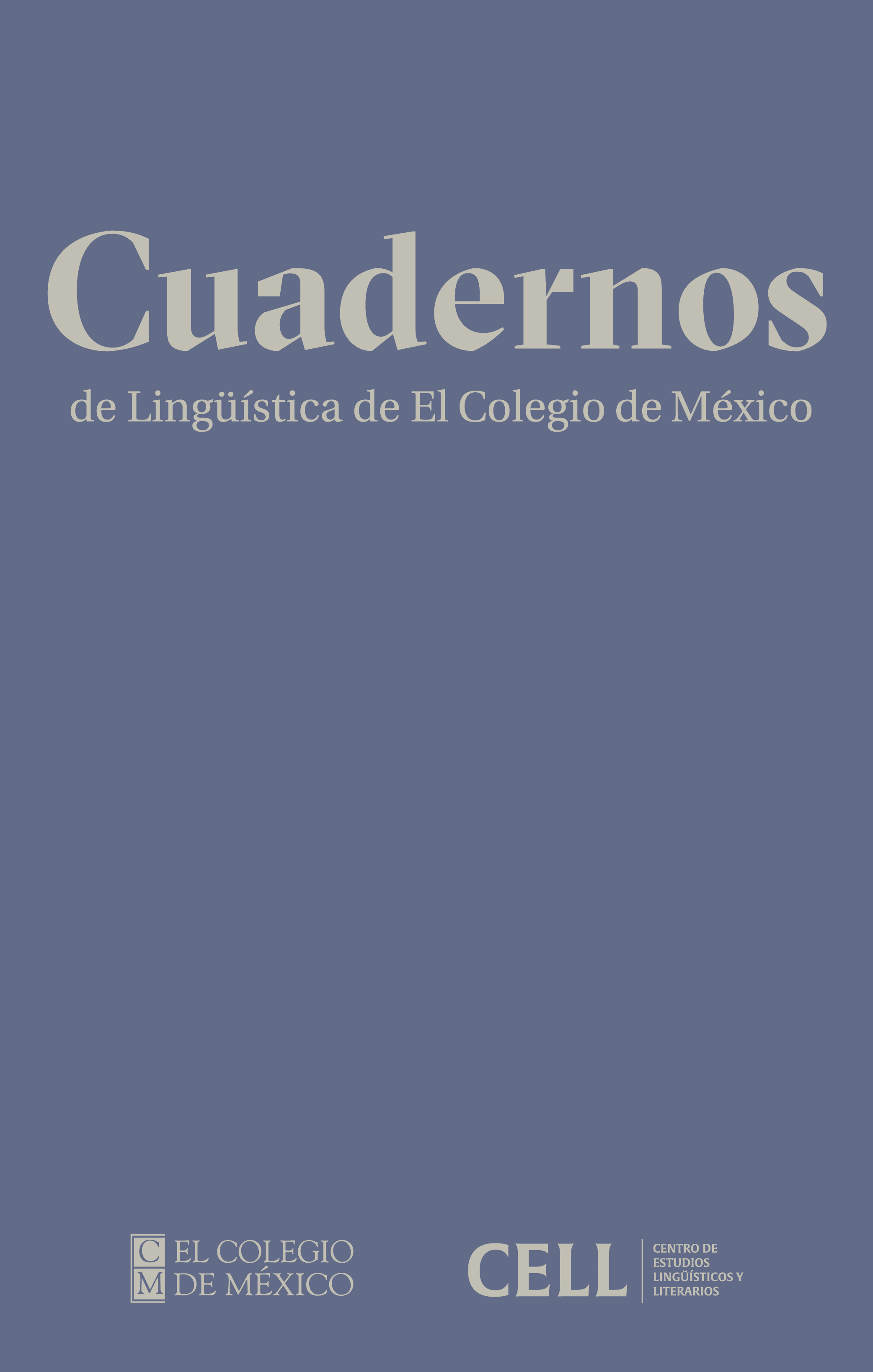The Chichimeco system of adpositions
DOI:
https://doi.org/10.24201/clecm.v10i00.271Keywords:
affix, clitic, applicative, instrument, location, change of route, quantification, referentiality, locative adverbs, relational nouns, verb typesAbstract
This paper describes the system of adpositions of úza̠ʼ or Chichimeco (Otopame, Otomangue) made up of a single element, the bound morpheme βa. It is shown that, according to its morphophonological properties, the morpheme βa can be realized as an affix or a clitic. Considering its syntactic properties, a functional overlap with applicativization is identified, since this morpheme is also used to promote peripheral participants to central participants. Semantically, the morpheme βa is related to the notions of instrument, location, change of route, quantification and referentiality. As for the development of the adpositional functions of this morpheme, the study argues that the grammatical nature of this adposition is directly related to the system of locative adverbs, relational nouns as well as locative, dispositional and motion verbs.
Downloads
References
Alexiadou, Artemis & Schäfer, Florian. 2006. Instrument subjects are agents or causers. En Baumer, Doland; Montero, David & Michael Scanlon (eds.), Proceedings of the 25th west coast conference on formal linguistics, 40-48. Somerville: Cascadilla Proceedings Project.
Ameka, Felix K. & Levinson, Stephen C. 2007. The typology and semantics of locative predicates: postural, positional and other beasts. Linguistics 45(5). 847-871. DOI: https://doi.org/10.1515/LING.2007.025
Bakker, Dill. 2013. Person marking on adpositions. En Dryer, Matthew S. & Haspelmath, Martin (eds.), The world atlas of language structures online. Leipzig: Max Planck Institute for Evolutionary Anthropology. http://wals.info/chapter/85 (Consultado el 12-11-2021.)
Blake, Barry J. 2001. Case. Cambridge: Cambridge University Press.
Bohnemeyer, Jürgen & Brown, Penélope. 2007. Standing divided: dispositional and locative predications in two Mayan languages. Linguistics 45. 1105-1151. DOI: https://doi.org/10.1515/LING.2007.033
Bresnan, Joan W. 1982. The mental representation of grammatical relations. Cambridge, MA: MIT Press.
Campbell, Lyle; Kaufman, Terrence & Smith-Stark, Thomas C. 1986. Meso-America as a linguistic area. Language 62(3). 530-570. DOI: https://doi.org/10.1353/lan.1986.0105
Campbell, Eric. W. 2017. Otomanguean historical linguistics: exploring the subgroups. Language and Linguistics Compass 11(7). 1-23. DOI: https://doi.org/10.1111/lnc3.12244
Comrie, Bernard. 1981. Language universals and linguistic typology: syntax and morphology. Chicago: University of Chicago Press.
Cruse, David. A. 1973. Some thoughts on agentivity. Journal of Linguistics 9. 11-23. DOI: https://doi.org/10.1017/S0022226700003509
DeLancey, Scott. 1984. Notes on agentivity and causation. Studies in Language 8(2). 181-213. DOI: https://doi.org/10.1075/sl.8.2.05del
DeLancey, Scott. 1991. Event construal and case role assignment. Proceedings of the annual meeting of the Berkeley linguistics society 17. 338-353. DOI: https://doi.org/10.3765/bls.v17i0.1610
Dryer, Matthew S. 2013. Order of adpositions and noun phrase. En Dryer, Matthew S. & Haspelmath, Martin (eds.), The world atlas of language structures online. Leipzig: Max Planck Institute for Evolutionary Anthropology. http://wals.info/chapter/48 (Consultado el 12-11-2021.)
Feist, Timothy & Palancar, Enrique L. 2021. Paradigmatic restructuring and the diachrony of stem alternations in Chichimeco. Language 97. 1-41. DOI: https://doi.org/10.1353/lan.2021.0000
Givón, Talmy. 2001. Syntax: A functional-typological introduction. Ámsterdam/Filadelfia: John Benjamins. DOI: https://doi.org/10.1075/z.syn1
Guerrero, Lilián (ed.). 2019. Adposiciones y elementos de su tipo en lenguas de América. México: Universidad Nacional Autónoma de México.
Hagège, Claude. 2010. Adpositions. Oxford: Oxford University Press.
Haspelmath, Martin. 2003. The geometry of grammatical meaning: Semantic maps and cross-linguistic comparison. En Tomasello, Michael (ed.), The new psychology of language: cognitive and functional approaches to language structure (2), 211-242. Mahwah/Nueva Jersey/Londres: Lawrence Erlbaum.
Haspelmath, Martin. 2019. Indexing and flagging, and head and dependent marking. Te Reo 62. 93-115.
Herce, Borja. 2023. Adpositions. En Van Lier, Eva (ed.), The Oxford handbook of word classes. Oxford: Oxford University Press. DOI: https://doi.org/10.1093/oxfordhb/9780198852889.013.12
Hernández Chincoya, Francisco. 2021. (Re)pensando la morfología nominal del chichimeco: clases posesivas y mutaciones consonánticas. (Trabajo presentado en el evento V Jornadas de Lingüística LINGUAQ. Querétaro: Universidad Autónoma de Querétaro.)
Hernández Chincoya, Francisco & Mora-Bustos, Armando. 2019. Adverbios por adposiciones. (Trabajo presentado en el Seminario Diacronía y adposiciones: origen y evolución. Hermosillo: Universidad de Sonora.)
Hernández Chincoya, Francisco & Mora-Bustos, Armando. 2020. Funciones del morfema =βa en chichimeco como candidato a adposición. (Trabajo presentado en el Seminario Diacronía, adposiciones y arguments nucleares y oblicuos. Hermosillo: Universidad de Sonora.)
Instituto Nacional de Lenguas Indígenas (inali). 2012. México. Lenguas indígenas nacionales en riesgo de desaparición: variantes lingüísticas por grado de riesgo.
Jolly, Julia. 1993. Preposition assignment in English. En Van Valin, Robert. Jr (ed.), Advances in Role and Reference Grammar, 275-310. Ámsterdam: John Benjamins. DOI: https://doi.org/10.1075/cilt.82.08jol
Kamp, Hans & Rossdeutscher, Antje. 1994. Remarks on lexical structure and DRS construction. Theoretical Linguistics 20. 97-164. DOI: https://doi.org/10.1515/thli.1994.20.2-3.97
Kearns, Kate. 2000. Semantics. Londres: Macmillan Press.
Kenesei, Istvan; Vago, Robert Michael & Fenyvesi, Anna. 1998. Hungarian. Londres: Taylor & Francis Routledge.
Kurzon, Dennis. & Adler, Silvia. 2008. Adpositions: pragmatic, semantic and syntactic perspectives. Ámsterdam: John Benjamins. DOI: https://doi.org/10.1075/tsl.74
Lakoff, George & Johnson, Mark. 1980. Metaphors we live by. Chicago: The University of Chicago Press.
Lastra, Yolanda. 2009. Vocabulario piloto chichimeco. México: Universidad Nacional Autónoma de México.
Lastra, Yolanda. 2018. Textos chichimecos. Bosquejo gramatical, léxico y notas históricas. Tomo I y II. México: Universidad Nacional Autónoma de México.
Levinson, Stephen. 2004. Space in language and cognition. Explorations in cognitive diversity. Cambridge: Cambridge University Press. DOI: https://doi.org/10.1017/CBO9780511613609
Libert, Alan R. 2013. Adpositions and other parts of speech. Frankfurt: Peter and AG. DOI: https://doi.org/10.3726/978-3-653-03682-4
Lillehaugen, Brook D. 2020. Otomanguean languages. En Siddiqi, Daniel; Barrie, Michael; Gillon, Carrie; Haugen, Jason D. & Mathieu, Éric (eds.), The Routledge handbook of North American languages, 331-364. Nueva York: Routledge. DOI: https://doi.org/10.4324/9781315210636-15
Lizárraga Navarro, Glenda Z. 2018. Morfología verbal de persona y número en chichimeco jonaz. Ciudad de México: El Colegio de México. (Tesis de doctorado.)
O’Meara, Carolyn & Pérez Báez, Gabriela. 2020. Morphosyntactic strategies in locative description. En Siddiqi, Daniel; Barrie, Michael; Gillon, Carrie; Haugen, Jason D. & Mathieu, Éric (eds.), The Routledge handbook of North American languages, 149-328. Nueva York: Routledge. DOI: https://doi.org/10.4324/9781315210636-6
Ortiz Villegas, Alejandra Itzel; Hernández Hernández, Natalia; Mora-Bustos, Armando & García Zúñiga, Hamlet A. 2021. Sistema locativo en tres lenguas otomangues. Anales de Antropología 55(2). 125-141. DOI: https://doi.org/10.22201/iia.24486221e.2021.77971
Palancar, Enrique L. (En prensa). Oto-Pamean. En Wichmann, Søren (ed.), The languages and linguistics of Middle and Central America: A comprehensive guide. https://hal.archives-ouvertes.fr/hal-01493977/document (Consultado el 12-11-2021.)
Rappaport Hovav, Malka & Levin, Beth. 1992. -er nominals: implications for a theory of argument structure. En Stowell, Tim & Wehrli, Eric (eds.), Syntax and semantics. Syntax and the lexicon (26), 229-290. Nueva York: Emerald Group Publishing Limited. DOI: https://doi.org/10.1163/9789004373181_009
Schlesinger, Izchak M. 1989. Instruments as agents: on the nature of semantic relations. Journal of Linguistics 25:189-210. DOI: https://doi.org/10.1017/S0022226700012147
Shopen, Timothy (ed.). 2007. Language typology and syntactic description. Clause structure. Cambridge: Cambridge University Press. DOI: https://doi.org/10.1017/CBO9780511619427
Stolz, Thomas; Stroh, Cornelia & Urdze, Aina. 2013. Comitatives and instrumentals. En Dryer, Matthew S. & Haspelmath, Martin (eds.), The World Atlas of Language Structures Online. Leipzig: Max Planck Institute for Evolutionary Anthropology. http://wals.info/chapter/52 (Consultado el 12-11-2021.)
Stolz, Thomas. 1996. Some instruments are really good companions - some are not. On syncretism and the typology of instrumentals and comitatives. Theoretical Linguistics 23. 113-200. DOI: https://doi.org/10.1515/thli.1997.23.1-2.113
Stolz, Thomas. 2001. To be with X is to have X: comitatives, instrumentals, locative, and predicative possession. Linguistics 39. 321-350. DOI: https://doi.org/10.1515/ling.2001.013
Talmy, Leonard. 1976. Semantic causative types. En Shibatani, Masayoshi (ed.). Syntax and semantics (6), The grammar of causatives constructions, 41–116. Nueva York: Academic Press. DOI: https://doi.org/10.1163/9789004368842_003
Van Valin, Robert Jr. 2005. Exploring the syntax-semantics interface. Cambridge: Cambridge University Press. DOI: https://doi.org/10.1017/CBO9780511610578.001
Van Valin, Robert Jr. & LaPolla, Randy. 1997. Syntax: structure, meaning, and function. Cambridge: Cambridge University Press. DOI: https://doi.org/10.1017/CBO9781139166799
Published
How to Cite
-
Abstract342
-
PDF (Español)169
-
XML (Español)9
-
EPUB (Español)15
-
Kindle (Español)68
-
MP3 (Español)8
Issue
Section
License
Copyright (c) 2023 Francisco Hernández Chincoya, Armando Mora Bustos

This work is licensed under a Creative Commons Attribution-NonCommercial-NoDerivatives 4.0 International License.
Authors retain copyright of their work and are free to disseminate it, make copies for any use, and/or deposit in any repository or archive of their choice, but they grant Cuadernos de Lingüística de El Colegio de México the right to publish the work for the first time. Authors agree to acknowledge Cuadernos de Lingüística de El Colegio de México as the site of original publication of their article / note / review through proper citation.
Articles appearing in Cuadernos de Lingüística de El Colegio de México are made available to readers under a Attribution-NonCommercial-NoDerivatives 4.0 International.









